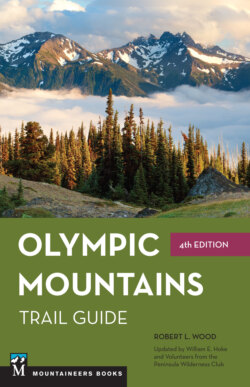Читать книгу Olympic Mountains Trail Guide - Robert Wood - Страница 12
На сайте Литреса книга снята с продажи.
INTRODUCTION
ОглавлениеThe Olympic Peninsula is located on the western coast of North America, approximately midway between the North Pole and the Equator, and marks the southern end of a fiorded coastline extending southeasterly from Cook Inlet, Alaska. The peninsula forms the northwestern corner of the conterminous United States and is bordered by saltwater on three sides—by the Pacific Ocean on the west, Puget Sound to the east, and the Strait of Juan de Fuca on the north. Only on the south is it connected to the mainland.
About half of the peninsula’s 6500 square miles is occupied by the Olympic Mountains. They dominate the interior and are surrounded by lowlands that seldom rise more than 500 feet above sea level. The point where the mountains begin is not a distinct line because they blend gradually into the lowlands.
Once covered with vast stands of virgin forest, the country surrounding the mountains has been greatly altered since the arrival of Europeans in the latter part of the eighteenth century. As a consequence of the Europeans’ impact, the area still in its natural state has been reduced to about fifty percent of what it was prior to the coming of Europeans to the Pacific Northwest.
Although the peninsula is located at a fairly high latitude, the nearby Pacific Ocean gives the land a mild marine climate. Extreme temperatures are unknown and precipitation is heavy, particularly on the windward side which faces the ocean. Here the rainfall often exceeds 140 inches a year, with still greater amounts deposited as snow at the higher elevations during the winter and spring. The summer and fall months are comparatively dry. The annual precipitation dwindles to about 20 inches in the northwest corner of the mountains’ leeward side, where the slopes stand as a barrier to storms that move inland from the sea.
